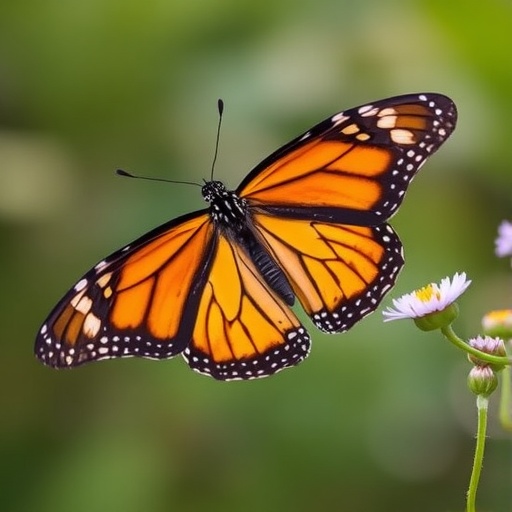In an unprecedented study published in PLOS One, researchers have uncovered the intricate mechanisms governing the remarkable navigational abilities of North American monarch butterflies (Danaus plexippus). These iconic insects are renowned for their awe-inspiring annual migration, spanning thousands of kilometers from breeding grounds in the northern United States and Canada to overwintering sites in central Mexico. While the role of celestial cues such as the sun and polarized light in monarch navigation has been extensively studied, this new research highlights the pivotal importance of magnetic field cues, revealing a nuanced integration modulated by cold temperatures that recalibrate the butterflies’ migratory orientation.
Monarch butterflies embark on their long-distance migration equipped with a sophisticated internal compass. Prior studies have demonstrated that monarchs rely heavily on the sun’s position and circadian rhythms to maintain a steady migratory direction. However, the evidence presented by this study reveals that magnetic fields — specifically Earth’s geomagnetic field — serve as indispensable navigational aids that monarchs depend on to delineate directionality during migration. The study elucidates that these magnetic cues are not utilized in isolation but are intricately recalibrated by environmental temperature, particularly coldness, which fine-tunes the butterflies’ orientation system.
Experimentally, researchers subjected migratory monarchs to controlled magnetic field manipulations within laboratory arenas, meticulously simulating various geomagnetic intensities and orientations. Crucially, when exposed to ambient cold temperatures akin to those experienced at high latitudes or during overwintering periods, the monarchs exhibited a realignment of their directional preference consistent with magnetic cues. In contrast, exposure to warmer temperatures diminished their reliance on magnetic input, illustrating a temperature-dependent mechanism that influences migratory behavior.
This thermally calibrated magnetic orientation suggests a form of sensory plasticity in monarchs, enabling them to adapt navigation strategies to seasonal environmental variations. Mechanistically, this plasticity likely involves magnetoreceptive molecules or structures within the monarch’s nervous system that respond differentially to cold, perhaps modulating neuronal signaling pathways involved in spatial orientation. Prior hypotheses have identified cryptochromes — blue-light photoreceptor proteins sensitive to magnetic fields — as potential molecular mediators, but this study emphasizes the modulating effect of temperature as a novel layer of complexity.
The reliance on cold temperatures to recalibrate magnetic orientation has profound ecological and evolutionary implications. As climate change continues to alter temperature patterns across the butterflies’ migratory range, disruptions in this finely tuned magnetic navigation system may contribute to the increasing challenges monarch populations face. Warmer winters or fluctuating cold spells could impair the butterflies’ ability to correctly interpret geomagnetic cues, potentially leading to migratory disorientation, failed overwintering, and long-term population decline.
Furthermore, the study’s findings prompt reconsideration of the multifaceted sensory strategies monarchs employ. The integration between magnetic sensing and thermal cues underscores a sophisticated neural mechanism that transcends simple binary cue use. It is possible that monarchs employ a hierarchical or context-dependent processing of environmental information, leveraging multiple sensory modalities to optimize migratory success under dynamic conditions.
Technically, the experimental methodology involved magnetic coil systems designed to manipulate Earth-strength magnetic fields without altering other environmental variables, such as light and humidity. The monarchs’ orientation behavior was monitored using circular flight arenas and tracked via high-resolution video systems. Behavioral assays were paired with temperature control chambers, ensuring robust examination of temperature effects. This rigorous approach allowed for the disentanglement of temperature and magnetic factors, an advancement over previous correlational studies.
The implications of these results extend beyond monarchs. Magnetic orientation is documented in various migratory taxa, including birds, sea turtles, and some insects. Understanding the modulatory role of temperature on magnetic navigation could reveal conserved physiological strategies across species, enhancing our grasp of animal migration amidst climate variability. Moreover, insights into the molecular and neural substrates affected by temperature may inspire biomimetic navigation technologies, leveraging environmentally responsive magnetic sensing.
Importantly, the study’s declaration of no specific funding underscores the dedication to advancing entomological and ecological knowledge absent external commercial influence, bolstering its scientific credibility. Additionally, the authors affirm no competing interests, emphasizing the neutrality and objectivity of their findings.
This paradigm shift in understanding monarch migration biology also raises urgent conservation questions. Monarch butterfly populations have suffered dramatic declines in recent decades, attributed to habitat loss, pesticide use, and climate perturbations. Integrating knowledge of magnetic and thermal navigation cues into conservation strategies could refine habitat protection, ensuring overwintering sites retain the environmental conditions necessary for successful reorientation and survival.
In conclusion, this groundbreaking research reveals that North American monarch butterflies execute their epic migratory journeys by harnessing magnetic field information, with orientation finely recalibrated by cold temperatures. This temperature-dependent magnetosensitivity exemplifies the sophisticated sensory ecology evolved by monarchs to navigate immense distances. As climate change threatens these environmental conditions, understanding such delicate bio-navigation systems becomes critical. Future research must delve deeper into the molecular and neural architecture enabling this thermal modulation, elucidating pathways to safeguard this migratory marvel.
As we peer into the complexity of monarch migration, these findings remind us of the intricate interplay between organisms and their environments — a delicate dance shaped by evolution, physiology, and the unseen forces of the Earth’s magnetic field.
Subject of Research: Monarch butterfly migration and magnetic orientation modulated by temperature
Article Title: Monarch butterflies (Danaus plexippus) only use magnetic cues for migratory directionality with orientation re-calibrated by coldness
News Publication Date: 13-Aug-2025
Web References: http://dx.doi.org/10.1371/journal.pone.0328737
Image Credits: Patrick A. Guerra, CC-BY 4.0
Keywords: Monarch butterflies, Danaus plexippus, migration, magnetic orientation, temperature recalibration, coldness, geomagnetic field, sensory ecology, climate change, navigation mechanisms, cryptochrome, sensory plasticity




